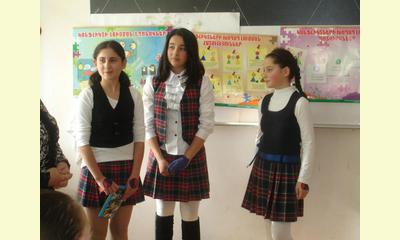|
|
The Armenian model of peace and conflict resolution education: from practice to policy
un article par Dr. Gohar Markosyan, Project Director and Manushak Aslanyan, Project specialist, Women for Development NGO
During the past thirteen years in the frames of the International Decade for a Culture of Peace and Non-Violence for the Children of the World announced by UN for 2001-2010 and UN Decade for Education for Sustainable Development (2005-2014), Women for Development NGO (WFD) based in Gyumri, Armenia has been implementing a project “Peace and Conflict Resolution Education in the Schools of Armenia” funded by the Church Development Service Germany/EED/ and Inter Church Organization for Development and Cooperation/ICCO/, the Netherlands.

click on photo to enlarge
The main goal of the project is to improve the quality of educational services provided in schools, to contribute to peaceful resolution of conflicts in school and community as well as to promote the culture of tolerance and peace among teachers and schoolchildren. The project has been introduced in a number of schools throughout Armenia having the perspective of including peace and conflict resolution education in the school curriculum.
The main strategy of the education includes organizing peace education sessions in schools, trainings for in and pre service teachers, increasing the participation of parents and most importantly cooperation with the National Institute of Education (NIE) RA Ministry of Education and Science.
The project commenced at school N 20 after L. Byron in Gyumri, and later it reached to more than 16 schools in Shirak region as well as the Gyumri State Pedagogical Institute having the aim to train pre service teachers as well. Starting from 2011 the project is being implemented in all regions of Armenia in cooperation with local branches of NIE of RA Ministry of Education and Science.
The process of project implementation can be divided into two main stages. In the first stage, the main activities were directed towards studying the international experience, capacity building of the NGO team, developing the primary teaching materials of peace and conflict resolution education, testing and evaluation, training students, organizing seminars for pre and in service teachers and informing parents.
In the Second Stage (2011-2013) , it was necessary to develop new approaches for trainings and teaching materials in order to transfer our experience in other regions of Armenia. The trainings had to be interesting for both teachers and students.
First of all, a new practical handbook for teachers “Conflict Resolution Education in Schools” was published in 2012. The practical handbook along with the posters provided the opportunity to summerize the basic ideas of peace education only in five classes. The main ideology is that conflicts are typical for all aspects of our lives, everyone has been and will be involved in conflict situations, conflicts have great impact on each person, family, organization and in general on humanity. Therefore, being able to manage these conflicts will greatly influence our lives and create an environment where violence will not be acceptable.
(This article is continued in the discussionboard)
|








|
DISCUSSION
Question(s) liée(s) à cet article:
Peace Studies in School Curricula , What would it take to make it happen around the world?
* * * * *
Commentaire le plus récent:
During the Asian Educators Symposium, we found out that Peace Education is still not part of the school curriculum in most countries. However, the participating teachers have been incorporating peace education in their teaching subjects, such as English, social studies, and character education. We all agreed that love and the will to nurture peace in children are the most important basis for peace education. Even if peace education is not a part of the curriculum, peace can be taught through any subject. Whatever you are teaching, if it comes from the heart, then it will touch the minds of children.

|
|









